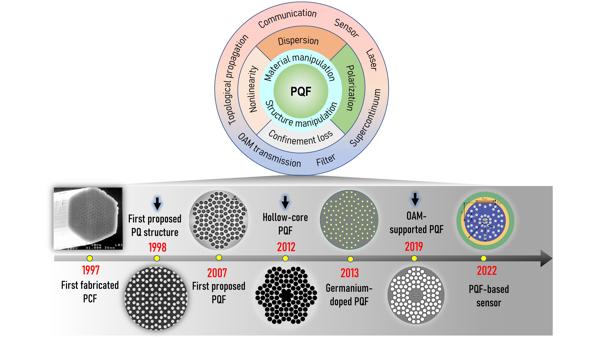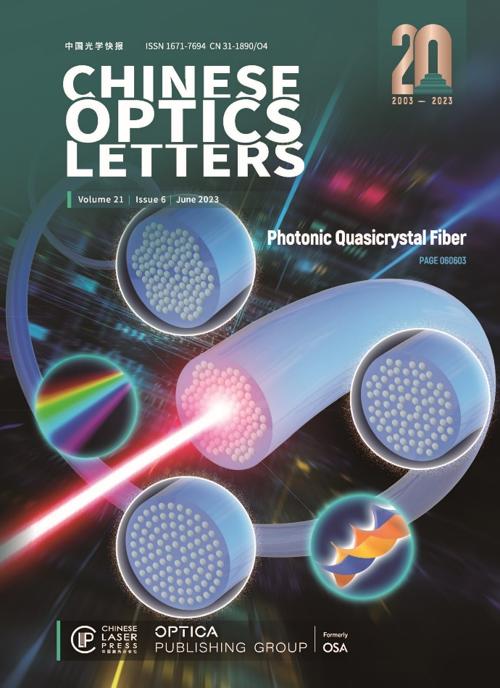Microstructure Fiber
Microstructure optical fiber (MOF) offers a wide range of applications in short-distance communication systems, fiber lasers, supercontinuum generation, sensors, modulators and wavelength converters, as well as in various scientific fields such as optics, electronics, medicine, biology and environmental science. Conventional step-index fibers suffer from the constraints of the monotonic structure construction and material properties, which limits the further optimization of their optical performance in terms of work bandwidth, dispersion and loss. For practical purposes such as high-capacity transmission and high-power lasers, they face the challenges such as maintaining single-mode operation with a small core size, ensuring a low cutoff wavelength and matching the thermal characteristics of the core and cladding materials. In contrast, MOF, such as the well-known photonic crystal fiber (PCF), exhibit a strong dependence of the effective refractive index of the cladding on the structural parameters and wavelength, which enables a broad tunability of the effective refractive index contrast (0 ~ 90%) between the core and cladding modes. Therefore, by adjusting the structural parameters of the fiber, such as the size, shape and lattice constant of the air holes, the fundamental mode propagation constant will be effectively controlled, easily achieving single-mode transmission with zero cutoff wavelength, high numerical aperture, ultra-flat dispersion, low loss or high nonlinearity coefficient, among other desirable fiber features. These features endow PCF with an unparalleled advantage over traditional fiber.
Photonic quasicrystal fiber: concept, structure classification, development milestones and prospective applications
Photonic quasicrystal fiber (PQF) (also named quasiperiodic PCF) is a special type of PCF that features rotational symmetry and long-range order, but not translational symmetry, in its air-hole arrangement structure. Unlike conventional PCF, PQF offers more structural flexibility, versatile mode manipulation techniques, diverse defect modes, and benefits for optimizing dispersion, confinement loss and nonlinearity coefficients, as well as designing novel fibers and fiber devices. PQF has emerged as a new frontier of innovation for fiber sensing, communication and other applications. The PQF structure can be divided into Stampfli-type, Penrose-type and Sunflower-type, which employs either total reflection-type or bandgap-type guiding mechanisms for mode transmission. The current researches on PQF applications covers dispersion compensation, polarization maintaining, sensor, filter, orbital angular momentum mode transmission and supercontinuum generation. The concept proposal, cross-section structure, development history and potential applications of PQF are shown in Fig. 1.

Figure 1. The concept proposal, cross-section structure, development history and potential applications of PQF.
Review of photonic quasicrystal fiber
Jianjun Liu, associate professor at the School of Physics and Electronics, Hunan University, and Exian Liu, lecturer at the Central South University of Forestry and Technology, have comprehensively reviewed the PQF. They first introduce the basic concept, working mechanism and development history of PQF, then summarize their optical performance optimization (such as dispersion control, polarization maintaining and high nonlinearity) and applications in optics (such as supercontinuum generation, orbital angular momentum mode transmission, plasmonic resonance sensing, filtering and topological mode transmission). The challenges faced by PQF in revealing the mode guidance mechanism and developing practical fabrication techniques are also addressed in detail. Finally, they outlook the future trends and prospects of PQFs. Their work is published in the 6th issue of the 21st volume of Chinese Optics Letters (Exian Liu and Jianjun Liu, Quasiperiodic photonic crystal fiber [Invited]), and is selected as the cover paper of that issue, as shown in Fig.2.

Figure 2. The cover image illustrates the photonic quasicrystal fiber (PQF), which is also named quasiperiodic photonic crystal fiber. The five insets surrounding the PQF end-face provide a simultaneous display of three typical structures and two representative potential applications of PQF. The three white-circled insets (top-left, right, and bottom-left) represent the Stampfli-type, Penrose-type, and Sunflower-type structures, respectively. The two blue-circled insets (left and bottom-right) show applications of the supercontinuum generation and orbital angular momentum mode propagation, respectively.


